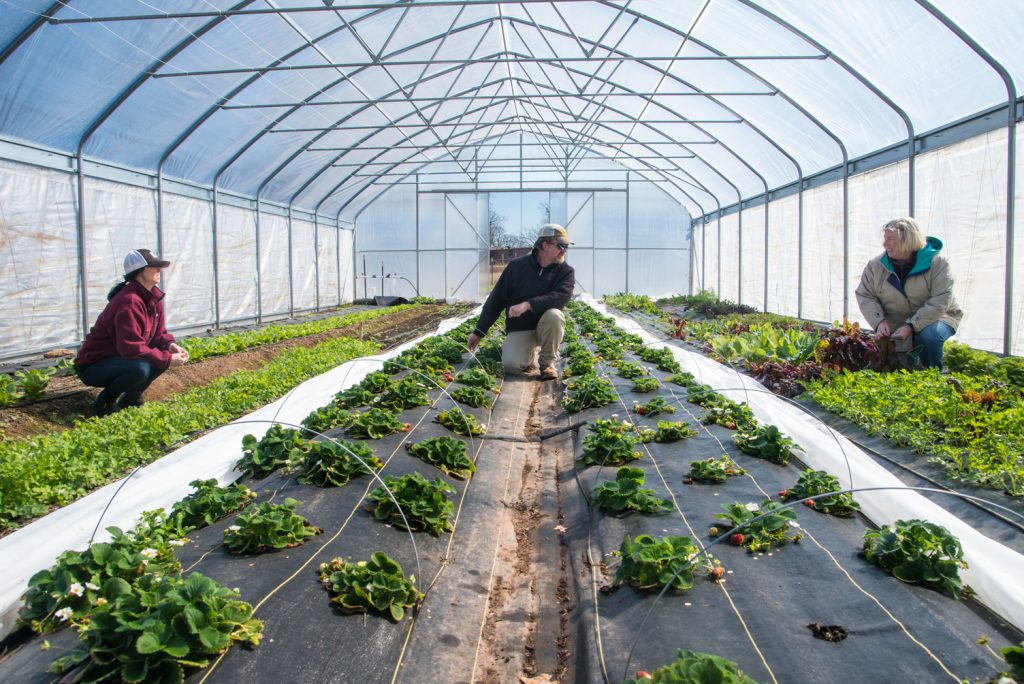Commissioned By The Governor’s Taskforce For Economic Recovery
COVID-19 has caused substantial economic dislocations in Arkansas and across the nation. It has accelerated changes that were already underway, such as the ability to work remotely on a large scale and the necessity for high-speed internet access to conduct commerce, obtain educational and workforce training and access medical services. States and communities that are able to address these issues and adapt quickly to the post-pandemic economy not only stand a better chance of recovering employment losses quickly, but they can also position themselves to benefit from new economic development trends that emerged during the pandemic.
Every crisis presents opportunities to think and act differently. This is the time for Arkansas to commit to transformational economic development plans and embark upon new strategic directions.
Heartland Forward’s objective is to provide guidance to state, regional and local policymakers and leaders that will position Arkansas’ economy to rebound and expand at a faster pace than envisioned prior to the pandemic.
To formulate an economic recovery strategy for Arkansas, Heartland Forward has conducted an extensive analysis of areas where Arkansas can build upon existing strengths and mitigate existing weaknesses. Our team has compiled and condensed comprehensive data on Arkansas’ economy in six primary areas:
• talent and workforce
• innovation and research
• entrepreneurship and small businesses
• health care
• supply chains and logistics
• high-speed internet
We augmented these hard data with focus groups and interviews of important actors in each of these vital sectors. We reached out to members of communities throughout the state to garner their informed assessment and ground our ideas. We have minimized our analytical elements to focus on big ideas with a series of specific recommendations for action. Some of our actions might be considered aspirational—if they weren’t, we didn’t accomplish our mandate—and perhaps viewed with a dose of skepticism.
Arkansas’ economy entered the pandemic with disparate growth patterns across the state. Northwest Arkansas was among the fastest-growing communities in the nation. Jonesboro has outperformed the nation, Little Rock and Central Arkansas slipping below it while the communities in the Delta, and Southwest Arkansas were losing population and resiliency. Therefore, different emphasis must be placed on recommendations contained in this strategy as they pertain to geography. However, we have attempted to create strategies to link statewide assets to distribute maximum benefit and impact.

1) Talent and Workforce
Creative, innovative and skilled talent is the defining ingredient for success in the knowledge economy. The most successful states and communities recognize that talent attraction, retention and development supplant industrial recruitment. Without talent, you can’t recruit companies that require it for success. Capital follows where talent is created or attracted as traditional incentives have less efficacy. Arkansas has made improvements in creating talent, but woefully lags other states in its commitment and execution of new training paradigms. There are two primary measures of talent: one is based upon degrees and credentials and another is tied to occupations of people. Just 23.3 percent of Arkansas’ above the age of 25 hold a bachelor’s degree, ranking the state 48th,1 while only 8.3 percent hold a graduate degree — 50th in the nation.2 Arkansas performs better based on those belonging to the creative class, where it ranks 43rd.3 Arkansas’ comparative strength lies second in the nation for the share of its workforce in skilled trades. This is important as the workforce segment presents upskilling opportunities. A key restraining factor on economic growth in Arkansas is the low engagement of women in the workforce, with their labor force participation rate at 69.6 percent (44th in the nation,) eight percentage points below men’s.4
Arkansas requires a multifaceted approach to improving its talent position. The state’s high quality of life, low housing costs with abundant recreational opportunities makes it attractive to the footloose talent that could relocate. Training partnerships between the private sector and community colleges will better align workforce skills with the requirement of employers. Additional focus on graduating more students with bachelor’s degrees (especially in science, technology, engineering and math – STEM – fields) and retaining them will boost the knowledge intensity of businesses in the state. Providing assistance to graduating international students with their visa status would allow Arkansas to retain this human capital investment. As the pandemic highlighted, the skills demanded by employers are changing rapidly, and Arkansas’ higher education system must adapt to generate a workforce that meets current skill needs but is nimble enough to meet future, possibly unknown, needs as well.
Recommendations
Arkansas needs to develop a cohesive and aligned talent creation, attraction and retention strategy. It should be tied to growing knowledge-based sectors such as data sciences, supply chain management, business services, health care, education and research and development. Apprenticeship programs, such as those provided by the Arkansas Center for Data Sciences,5 providing employed trainees with experiential knowledge at multiple levels of career paths should be adopted. For attraction, the state’s quality of life and family-friendly features should be stressed. Building upon Northwest Arkansas’ successful Life Works Here remote incentive program, offering relocation tax credits to individuals with skills in demand could jump-start this effort. Leaders in the state need to take bold initiatives to transform the state’s high-skilled talent base, such as doubling the number of engineering graduates within ten years and a proportionally larger gain in data sciences. This would build upon and be enabled by Governor Hutchinson’s Computer Science Initiative that provides exposure to computer science and coding.6 More flexible credentialing at community colleges and universities in high-demand occupations are necessary. The state needs to transform its high school programs to provide career pathways and apprenticeship programs for students.
The “Ready for Life” platform will align workforce development services and outcomes across the state; adoption at all education levels and by companies throughout the state could make it transformative. Technology should be infused into the curriculum consistent with those being deployed within the industry. Arkansas must target women for upskilling and retraining for opportunity occupations. A statewide initiative to provide women entrepreneurs with mentorship, technical assistance and capital should be considered. Employers should provide childcare services to women obtaining additional training, and philanthropy and state government should partner to provide it to those seeking to switch or enter professions.
2) Innovation and Research
High levels of innovation and research activity separate places creating well-paying jobs from those languishing, so Arkansas should elevate these activities to play a critical role in its economic recovery strategy.7 Commercialization of university research, along with industry-performed research and development (R&D,) are key sources of knowledge-intensive economic growth. Industry clusters can be built and enhanced by actors staying at the innovation frontier. Arkansas captured $179 million of federal science and engineering funding in 2019, ranking it 50th per capita.8 Arkansas must pursue its Science and Technology Plans updated in 2018 more aggressively and with greater commitment.9
These are investments in the future of Arkansas’ economy and workforce. Arkansas’ congressional delegation, the governor’s office and university leaders should actively advocate to federal agencies for additional research funding. The University of Arkansas System, especially UA-Fayetteville and UA for Medical Sciences, are positioned to make a strong case for additional funding.
Recommendations
The state’s economic development efforts must embrace innovation as fundamental to its long-term growth objectives. An important signal of the state’s commitment would be to increase and make permanent funding for the Arkansas Economic Development Commission (AEDC) and to identify and support ventures with high-growth potential. The AEDC should realign incentives and metrics with knowledge-based economic development.
The state should provide matching funds for Small Business Technology Transfer (STTR) grants. Consideration should be given to scaling up the Science Studio model for supporting Arkansas start-ups as they pursue these grants. Arkansas should utilize the State Small Business Credit Initiative (SSBCI) funds of up to $56 million to make additional early-stage risk capital available. Funding for the Arkansas Research Alliance (ARA) to recruit faculty interested in generating intellectual property useful to local industries also enhances the knowledge-based economy. Greater emphasis should be placed on the ARA engaging with private sector firms to obtain additional funding. A hub and spoke system approach should be implemented to diffuse innovative activity through regional campuses such as UA -Monticello and -Fort Smith. Surveys should be conducted to assess business attitudes and experiences toward academic partnerships. Northwest Arkansas, with state support, should begin to develop a plan for why the region should be chosen as one of the 20 regional technology hubs contained in the U.S. Innovation and Competition Act legislation.

3) Entrepreneurship and Small Businesses
Entrepreneurs play an equally critical role in economic development as innovation and research. They are responsible for commercializing innovations and seize opportunities that many larger firms don’t recognize or deem unworthy of investment. Through scaling their businesses, they add employees and infuse new revenue into the state’s economy. Arkansas has a rich history of entrepreneurs such as Sam Walton, John H. Johnson, founder of Ebony and Jet magazines, and current entrepreneurs like April Seggebruch and her partner Stan Zolowski, founders of Movista, who are revolutionizing retail store management. Young firms (less than six years of age) are responsible for 10 percent of private-sector firm employment in Arkansas, while the national figure is 10.8 percent.10 Arkansas performs worst among knowledge-intensive young firms (those with a high percentage of employees with a bachelor’s degree or above.) These are the high-paying jobs that Arkansas requires to generate stronger economic growth for the state.11 Arkansas attracts little venture capital or angel investment and is 43rd in the proportion of eligible individuals that are accredited investors.12 The pandemic presents new opportunities for Arkansas to focus more attention and resources on entrepreneurship for economic development and job creation.
Recommendations
Just as Arkansas must embrace innovation and research, it must support its entrepreneurs and explicitly incorporate entrepreneurship as a key strategy for growing and diversifying its economy. A good first step was establishing the Small Business and Entrepreneurship program area at the AEDC. Now it must display its commitment by providing sufficient funding and resources to the division and altering economic development metrics for it to be impactful. Incentives should be redirected from industrial recruitment to target young firms. Additional funding of entrepreneurial support organizations (ESOs,) such as the Arkansas Small Business and Technology Development Center, can assist in spreading resources to rural parts of the state. These ESOs must collaborate more closely and exchange information to maximize the efficient delivery of services. Start-up funding for new businesses would be enhanced by altering the metrics of state-controlled risk capital funds to be more focused on Arkansas-based firms rather than primarily the rate of return on investment. Programs to assist entrepreneurs through the funding process and build entrepreneurial-support capacity in communities across the state are needed. Winrock International can play an enlarged role in providing these support services. More emphasis on forming mentorship support networks throughout the state is required. Arkansas should bring its personal income tax structure in line with neighboring states to encourage entrepreneurs to invest in businesses and reduce obstacles that encourage them to move to neighboring states.
4) Health Care
The COVID-19 pandemic has demonstrated the need to shift to a value-based system where payments are more aligned with health outcomes rather than a fee-for-service model. High rates of chronic conditions laid bare the need to address Arkansas’ poor performance on social determinants of health, such as the state’s obesity rate of 37.4 percent—third highest in the nation.13 Low income families in Arkansas have limited access to health care services, and the state is 47th for employer-provided insurance coverage of its population.14 Even when minorities have coverage, they don’t seek care regularly. The health care sector, including the life sciences, has been among the fastest-growing sectors of the U.S. economy. However, in Arkansas, it is seen as a rapidly rising cost requiring more state resources being directed at it. The state must have a more balanced perspective that recognizes health care as a source of economic growth. Arkansas should invest in developing nationally recognized areas of research, training and clinical care and translate these competencies into new commercial enterprises or new lines of business at established firms.
Recommendations
Strategic investments of public funds in educating residents about chronic disease and mental health are a necessity. Additional funding for the Arkansas Center for Health Improvement (ACHI) and a collaborative program with providers, insurers and others in the health community to develop these programs are necessary to reverse Arkansas’ poor position on the social determinants of health. Approval and full implementation of the Arkansas Health & Opportunity for Me (ARHOME) could expand coverage to an estimated 300,000 people, encourage healthy behaviors and bring more participants into work.15 Maintaining reimbursement parity between telemedicine and in-person service delivery in rural locations and expanding high-speed internet access is necessary to improve access. Arkansas can be among the national leaders in moving to value-based payment programs by building upon the work of Arkansas Blue Cross Blue Shield and the expertise of the Whole Health Institute. More Blacks and people of color must be targeted for potential careers as physicians and health care professionals.
The state should establish a unique medical and research cluster by building on existing assets such as the University of Arkansas for Medical Sciences (UAMS,) the two new schools of medicine in Jonesboro and Fort Smith and the announced Whole Health School of Medicine and Health Sciences in Bentonville, the forthcoming University of Arkansas Institute for Integrative and Innovative Research (I3R) in Fayetteville and the National Center for Toxicological Research (NCTR) in Jefferson. Additional state funding should be allocated to UAMS’ Winthrop P. Rockefeller Institute to secure National Cancer Institute Cancer Center designation. The BioVentures program at UAMS, which seeks to foster medical innovations and bring them to market through incubating startups, should be championed and receive increased public financial support. An annual report on the economic impact of health care and the life sciences should be prepared to demonstrate and advocate for the industry.
5) Supply Chains and Logistics
The knowledge economy is not just about software, digital media and other intangibles. Manufacturing and the movement of goods in the physical world are essential elements of Arkansas’ economy. Transportation occupations account for 9 percent of American jobs, having grown by almost 25 percent over the last five years,16 while production occupations in factories have declined 6.5 percent over the same time frame.17 Arkansas’ performance reflects these national patterns very closely. And with e-commerce sales growing as a share of retail sales (they increased from 11 percent in 2019 to 14 percent in 2020),18Arkansas has a significant competitive advantage. Arkansas has the third-highest share of transportation industry employment in the nation—almost double the U.S. average.19 J.B. Hunt, a leading U.S. transportation company, and other innovators in this space, such as ArcBest, as well as the global supply-chain expert in the U.S., Walmart, are all headquartered in Arkansas. Further, the University of Arkansas’ Sam M. Walton College of Business boasts the top undergraduate program in supply chain management in the U.S.

6) High-Speed Internet
The pandemic made Arkansans acutely aware that access and adoption of high-speed internet impact economic development and quality of life. In 2019, 20 percent of Arkansans did not have internet access, and 18 percent of households with connectivity only had a cellular data plan. Further, 122,600 Arkansan households did not have access to any computing device, including a smartphone.20 The share of households without internet access ranges from 7.1 percent in Benton County to 35.1 percent in Woodruff County.21 Several internet service providers and rural electric cooperatives began 2020 with plans and federal funding to increase high-speed internet availability throughout the state. Governor Hutchinson’s administration addressed the need by allocating $125 million of the state’s Coronavirus Aid, Relief and Economic Security Act (CARES Act) funding to the Arkansas Rural Connect (ARC) program.22 Additionally, regulatory changes were made to allow municipalities to provide high-speed internet services to constituents.
Recommendations
Arkansas must leverage these existing strengths and make further investments in training and methods to become a national leader in supply chain, logistics and transportation services, and a larger player in the e-commerce revolution. The state should embrace a “new” type of blue-collar work found in the transportation and logistics sectors. A statewide assessment of workforce needs, such as truck driver occupations where many reach retirement age, should be undertaken. Community colleges and other training regimes should partner closely with firms to develop quick-to-market training. Arkansas should develop a supply chain cluster initiative, connecting its supply chain expertise at UA-Fayetteville to industrial and rural-based sectors located throughout the state. An emphasis should be placed on growing more small- and medium-sized logistics, supply chain and transportation firms in the state’s diverse regions. Investments in port and land-based infrastructure are necessary to support Arkansas’ position. By investing in innovations, Arkansas can become a leading laboratory for supply chain management. The University of Arkansas’ Supply Chain Management Research Center should expand to include a specific focus on creating a technological frontier advantage relative to other research centers.
Recommendations
Arkansas should increase funding for deployment efforts to achieve aspirational levels of internet connectivity for Arkansans and ensure expansion and technological upgrades of the broadband infrastructure over time. The state can elevate funding for ARC and the Arkansas High Cost Fund (AHCF) to ensure continued expansion of broadband access in rural areas. Additionally, infrastructure providers should determine the optimum deployment projects to maximize user access while minimizing the marginal costs of adding customers; thus, the state should not restrict infrastructure funding to areas with low or no-service regions. Multiple technologies should be incentivized, and the state should not attempt to select winners. Emergency Broadband Benefits (EBB) information must be provided through non-internet media. The state should subsidize the cost of minimum standards for high-speed internet services where they are available. Arkansas should deploy Heartland Forward’s Connectivity Corps of fellows to educate underserved communities in using devices to access the internet and how to subscribe to available broadband services.
Conclusion
This strategy is not intended to be a detailed economic development blueprint for Arkansas encompassing all required actions. It will not replace existing plans, but it serves to build upon those and provide guidance on how Arkansas can adapt and capitalize on opportunities presented by the COVID-19 pandemic. Arkansas has the incredible prospect to emerge out of the disruption in an advantageous position. As people and firms ease back into the “new normal,” time is of the essence. Arkansas needs to move swiftly to attract talent, beef up its cluster strategies, upskill its workforce, prioritize research, embrace innovative endeavors, focus on and support entrepreneurs more fully, transform its health care services delivery model to reflect its potential as an economic development engine, and expand access to high-speed internet in underserved communities before people fall back into their old pre-pandemic patterns. This is Arkansas’ moment to transform and dispel negative perceptions of the state. In some sense, it is a rebranding opportunity. The state can leverage and enhance work that the Arkansas Department of Commerce has performed (www.arkansas.com) on a digital platform for “welcome to Arkansas.” Rebranding will require that Arkansas is perceived as open and tolerant of talented, diverse and creative people. Any actions that are not seen as welcoming of new ideas and people will be counterproductive. Leadership in the state must follow through by assigning responsibilities and committing to executing the strategies contained in this report.

ENDNOTES
1 American Community Survey. (2020). Table S1501: Educational
attainment (2019 1-year estimates) [Data set]. U.S. Census Bureau. https://
data.census.gov
2 Ibid.
3 Florida, R., Mellander, C., & Stolarick, K. (2008). Inside the black box
of regional development—human capital, the creative class and tolerance.
Journal of Economic Geography, 8(5), 615–649. https://doi.org/10.1093/jeg/
lbn023
4 American Community Survey. (2020). Table S2301: Employment
status (2019 1-year estimates) [Data set]. U.S. Census Bureau. https://data.
census.gov
5 Arkansas Center for Data Sciences. (2021). What is an
apprenticeship? https://acds.co/apprenticeship
6 State of Arkansas. (2021). Computer science initiative. Arkansas
Governor Asa Hutchinson. https://governor.arkansas.gov/computerscience/
7 Romer, Paul M. (1990). Endogenous technological change. Journal
of Political Economy, 98(5, Part 2), S71-S102.
8 National Center for Science and Engineering Statistics. (2019).
Federal funds for research and development [Data set]. National Science
Foundation.
9 Arkansas Science Advisory Committee. (2018). Arkansas 2018
science and technology plan. State_st_plan.pdf. Arkansas Economic
Development Corporation. https://www.arkansasedc.com/docs/defaultsource/
s-t/state_st_plan.pdf?sfvrsn=c3c7704a_2
10 Longitudinal-Employer Household Dynamics Program. (2021).
Quarterly workforce indicators, 1990-2020 (V4.7.0, R2021Q1) [Data set].
U.S. Census Bureau. https://ledextract.ces.census.gov.
11 Crews, J., DeVol, R., Florida, R., & Shideler, D. (2020). Young firms
and regional economic growth: Knowledge-intensive entrepreneurs critical.
Heartland Forward. https://heartlandforward.org/case_studies/youngfirms-
and-regional-economic-growth
12 Lai, Y.L. (2021). Not everyone wants to be an angel – especially in
the heartland. Heartland Forward. https://heartlandforward.org/case-study/
not-everyone-wants-to-be-an-angel-especially-in-the-heartland/
13 Division of Nutrition, Physical Activity, and Obesity. (2021, March 31).
Adult obesity prevalence maps. Center for Disease Control and Prevention.
https://www.cdc.gov/obesity/data/prevalence-maps.html#states
14 Kaiser Family Foundation. (2019). Health insurance coverage of the
total population. https://www.kff.org/other/state-indicator/total-population
/?currentTimeframe=0&sortModel=%7B%22colId%22:%22Location%22,%22
sort%22:%22asc%22%7D
15 Wickline, M. & Herzog, R. (2021, April 21). Medicaid funding gains
house’s OK. Arkansas Democrat Gazette. https://www.arkansasonline.com/
news/2021/apr/21/medicaid-funding-gains-houses-ok/
16 Occupational Employment and Wage Statistics. (2020, May).
Occupational Employment Statistics: National [Data set]. U.S. Bureau of
Labor Statistics. https://www.bls.gov/oes/current/oes_nat.htm
17 Ibid.
18 Economic Indicators Division, Retail Indicator Branch. (2021,
February 19). Quarterly retail e-commerce sales: 4th quarter. U.S. Census
Bureau. https://www.census.gov/retail/mrts/www/data/pdf/ec_current.pdf
19 Chmura Economics & Analytics. (2021). JobsEQ+ [Data set]. https://
www.chmura.com/software
20 American Community Survey. (2020). Table S2801: Types of
Computers and Internet Subscriptions (2019 1-year estimates) [Data set].
U.S. Census Bureau. https://data.census.gov
21 American Community Survey. (2020). Table S2801: Types of
Computers and Internet Subscriptions (2019 5-year estimates) [Data set].
U.S. Census Bureau. https://data.census.gov
22 Holtmeyer, D. & Perozek, D. (2020, September 13). Internet access a
state education text. Northwest Arkansas Democrat Gazette. https://www.
nwaonline.com/news/2020/sep/13/making-connection/
